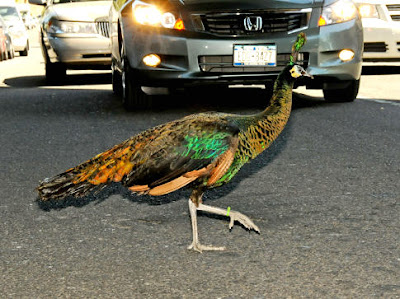

I'm not sure how this slipped by me for so long, but twice a year (at the end of May and again in mid-July), the sun is perfectly aligned with the east-west street grid of Manhattan. The event happened most recently yesterday, and made for a spectacular sunset at 8:17pm. It was dubbed "Manhattanhenge" by astronomer Neil deGrasse Tyson, director of the Hayden Planetarium at the American Museum of Natural History. Dr. Tyson writes, "What will future civilizations think of Manhattan Island when they dig it up and find a carefully laid out
 network of streets and avenues? Surely the grid would be presumed to have astronomical significance, just as we have found for the pre-historic circle of large vertical rocks known as Stonehenge, in the Salisbury Plain of England. For Stonehenge, the special day is the summer solstice, when the Sun rises in perfect alignment with several of the stones, signaling the change of season. For Manhattan, a place where evening matters more than morning, that special day comes twice a year. For 2011 they fall on May 30th, and July 12th, when the setting Sun aligns precisely with the Manhattan street grid, creating a radiant glow of light across Manhattan's brick and steel canyons, simultaneously illuminating both the north and south sides of every cross street of the borough's grid. A rare and beautiful sight. These two days happen to correspond with Memorial Day and Baseball's All Star break. Future anthropologists might conclude that, via the Sun, the people who called themselves Americans worshiped War and Baseball." Of course, they might be thrown by the fact that a similar alignment occurs at other times of the year in Chicago and Toronto.
network of streets and avenues? Surely the grid would be presumed to have astronomical significance, just as we have found for the pre-historic circle of large vertical rocks known as Stonehenge, in the Salisbury Plain of England. For Stonehenge, the special day is the summer solstice, when the Sun rises in perfect alignment with several of the stones, signaling the change of season. For Manhattan, a place where evening matters more than morning, that special day comes twice a year. For 2011 they fall on May 30th, and July 12th, when the setting Sun aligns precisely with the Manhattan street grid, creating a radiant glow of light across Manhattan's brick and steel canyons, simultaneously illuminating both the north and south sides of every cross street of the borough's grid. A rare and beautiful sight. These two days happen to correspond with Memorial Day and Baseball's All Star break. Future anthropologists might conclude that, via the Sun, the people who called themselves Americans worshiped War and Baseball." Of course, they might be thrown by the fact that a similar alignment occurs at other times of the year in Chicago and Toronto.1st image) The sun sets down 34th St. as viewed from Park Ave. on July 13, 2007, in a photo taken by astronomer Neil deGrasse Tyson, 2nd image set) Manhattanhenge photographed 2007-2009, 3rd image) Looking west along 42nd Street at 8:23pm on July 13, 2006.























































